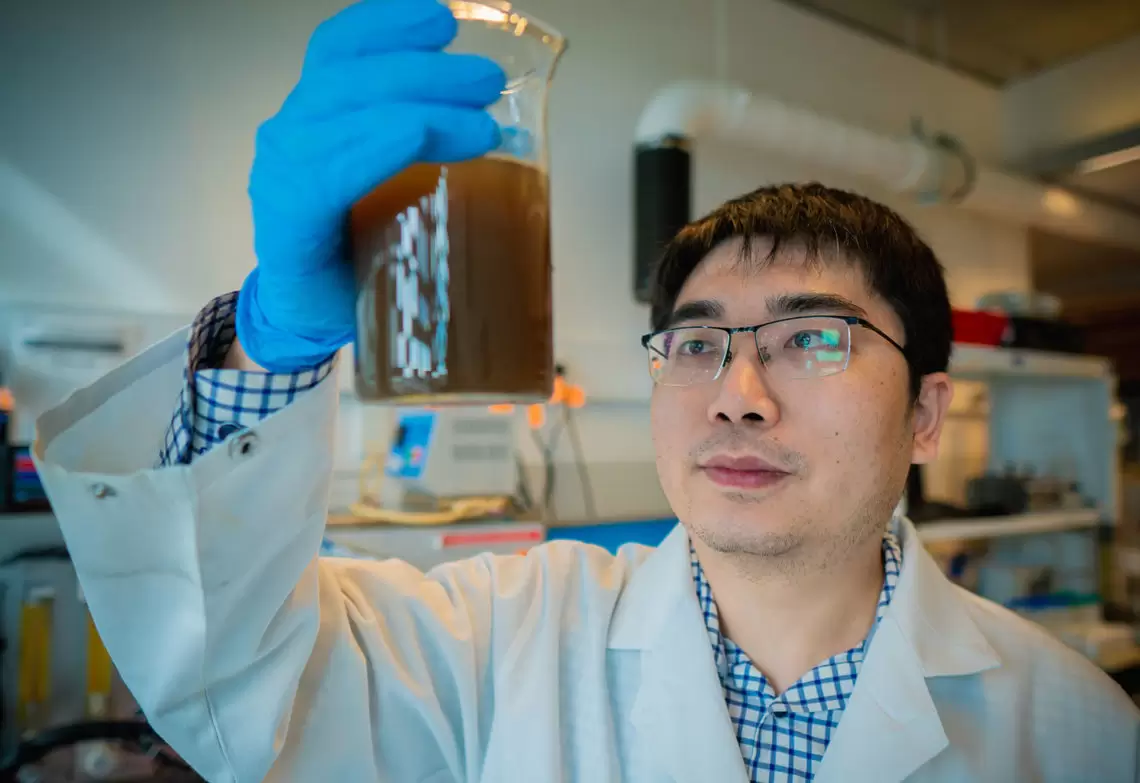Qilin Wang’s closed-system approach to water treatment could see a range of benefits for the planet.
Treating wastewater is an energy-intensive process, and that’s not its only impact on the environment.
It also creates ammonia as a non-biodegradable by-product, a substance that disrupts the balance of nutrients in the waterways in which it is discharged.
University of Technology Sydney Senior Lecturer Dr Qilin Wang, however, has found a way to deal with both of these issues.
He was awarded the 2020 Eureka Prize for Outstanding Early Career Researcher for this work.
Wang proposes using the ammonia for energy — removing it as a harmful waste product from the treatment process and having it power the very activity that produces it.
“The purpose of my research is to try to enhance energy recovery from wastewater to convert the wastewater treatment plant from a large energy consumer into an energy producer,” he told create.
“I also want to achieve low-emission wastewater treatment. In order to do that, I need to enhance the renewable energy recovery from the wastewater.”
The ammonia technique is one approach. Wang explains that this involves a part of the wastewater treatment system called an anaerobic digester.
Energy from ammonia
“The anaerobic digester produces liquor called anaerobic digester liquor,” Wang said.
“The anaerobic digester liquor contains a high amount of free ammonia, so in that case I can use this by-product of wastewater treatment, free ammonia, for other purposes — for instance, to treat some organics to enhance energy recovery.”
The other approach is to free up more organic components already in the wastewater for energy recovery.
“These organics can be converted to biogas,” Wang said.
“Biogas is a type of energy, so that’s a way we can recover energy from wastewater. But these types of organics in wastewater have a low biodegradability, so one thing my technology can do is transform some of the non-biodegradable organics into biodegradable organics. In that case I can directly enhance energy recovery from wastewater.”
Wang said one of the primary purposes of wastewater treatment is to remove nitrogen.
“But the nitrogen removal process also needs organics,” he said.
“The other thing that my technology can do is to change the nitrogen removal process in order to free up more organics for biogas production. In that case, I can indirectly enhance recovery from wastewater.”
The process still requires removing the ammonia from the treatment plant, but it maximises the energy derived before doing so.
“[In] a current wastewater treatment plant, they will remove it directly, without further use,” Wang said.
The process can also be carried out without adding further chemicals.
“Because my technology only relies on a chemical that can be directly obtained from the wastewater itself, it will require a minimum external chemical or energy input,” Wang said.
“It does not require external chemical input or external energy. That’s a big advantage of my technology.”
From lab to life
Wang’s ingenuity saw him selected as one of create’s Most Innovative Engineers for 2020.
At the moment, the research has been tested in the laboratory and in field tests overseas.
“I want to test some other parameters,” he said.
“Dewaterability and pathogen removal, and also maybe some other micropollutants removal from the wastewater … to see whether this technology can also remove those types of things.
“After that, then I want to talk to more potential industry partners to collaborate with to see how I can scale up this technology.”

Powering the plant
Wang said the energy produced by his wastewater treatment process could have a variety of uses.
The most straightforward of these is to power the treatment process itself.
“It can be used to power the operation of the wastewater treatment plant and it can also be used for other purposes,” he said.
“The wastewater treatment consumes lots of energy, so definitely it’s the first thing we want to use this type of recurrent energy for — to power the operation of the wastewater treatment plant.”
But it is also possible that, even having powered the treatment process, there could be energy left over.
“If we’ve still got some extra energy left, definitely this energy can be exported to the building or can be put into the grid for some other purposes,” Wang said.
“It can be converted to electricity or it can also be converted to heat; the heat can be used to warm the building.”
This article first appeared as “Clean water, clean energy” in the October 2020 issue of create magazine.



